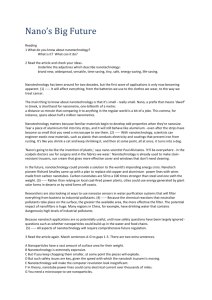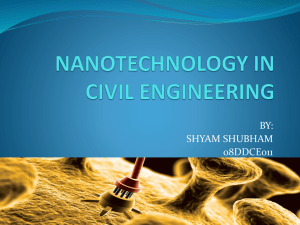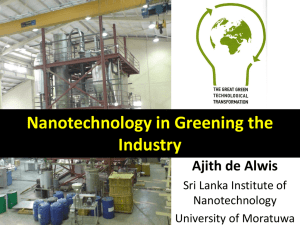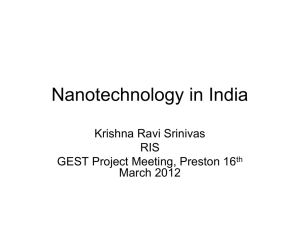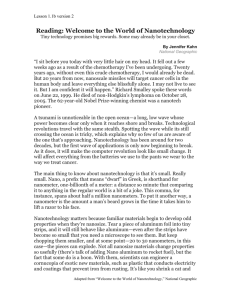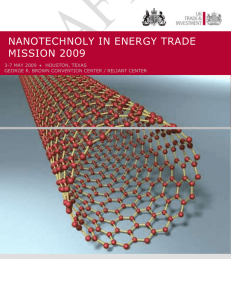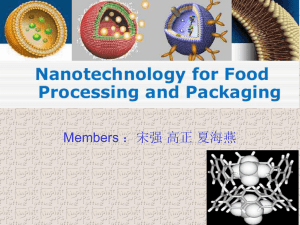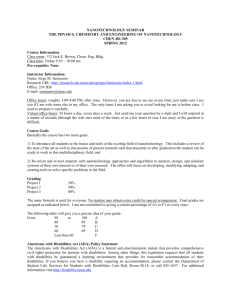and Nanotechnology
advertisement
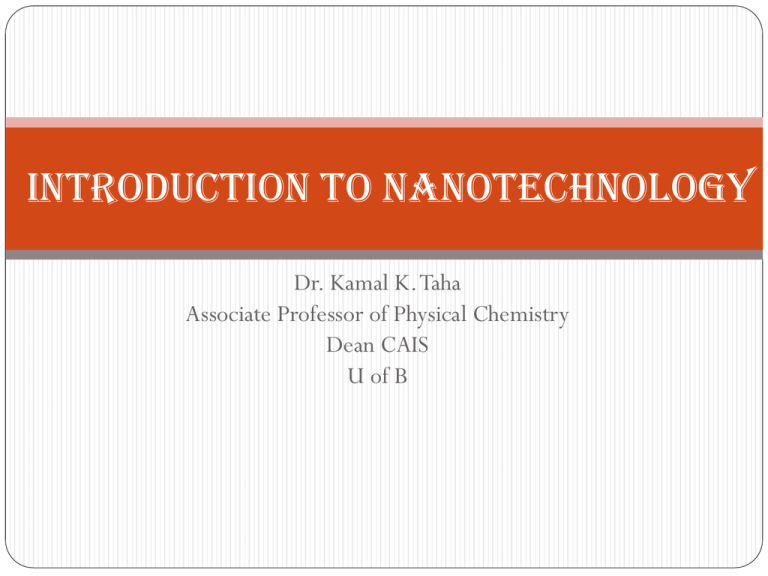
Introduction to Nanotechnology Dr. Kamal K. Taha Associate Professor of Physical Chemistry Dean CAIS U of B Definition Nanotechnology, shortened to “nanotech”, is the study of the controlling of matter on an atomic and molecular scale. Generally nanotechnology deals with structures sized between 1 to 100 nanometer in at least one dimension and involve developing materials or devices within that size. How small is Nano - small? Units in nanometers (µm) Compared to Human Hair A Human Hair is about 100,000µm wide At small size physical observation simply changes. It is no longer governed by the classical picture. Nano-structures & Sensitivity As objects are scaled down the ratio of the surface to volume increases sharply. This makes surface effects more pronounced. Isolated small size electrode will possesses high sensitivity due to non-linearity effects. Chemical Synthesis LOW temperature methods Hydrothermal chemical growth of ZnO Different Nano-structrures Obtained by controlling the reaction parameters Nanotechnology spans many Areas Information Technology Biotechnology Mechanical Mechanical Eng. Engineering & / Robotics Transportation Advance Materials & Textiles NANOTECHNOLOGY National Security & Defense Energy & Environment Aerospace Medicine / Health Food and Agriculture Nanosized Iron for Groundwater Remediation: Smaller sized iron particles More complete reduction of chlorinated hydrocarbons Absorbents for selective removal of pollutants • Teabag catalysts for de-stenching • Use high surface area Cu-ZnO catalysts to absorb S - compounds Treatment & Remediation End-of-pipe management and cleanup of pollution Iron Treatment Walls… Used in groundwater treatment for many years. Iron chemically reduces organic and inorganic environmental contaminants. Currently involves granular or “microscale” iron ( 50 mm or 50,000 nm). and Nanotechnology Nanosized iron enhances the reaction. Enhanced further by coupling with other metals (Fe/Pd)* on the nanoscale. Nano Fe0 is more reactive and effective than the microscale. Smaller size makes it more flexible -penetrates difficult to access areas. * Elliot and Zhang ES&T 2001, 35, 4922-4926 “Sense and Shoot” Approach to Pollution Treatment Dual role of ZnO semicondouctor film as a sensor and photocatalyst Nanosized zinc oxide (ZnO) “senses” organic pollutants indicated by change in visible emission signal. The ZnO “shoots” the pollutants via photocatalytic oxidation to form more environmentally benign compounds. >300 nm UV Sensing capability means that the energyconsuming oxidation stage only occurs when the pollutants present. Multifunctionality and “smartness” is highly desirable for environmental applications. Kamat, P.V, et al. J.Phys.Chem. B 2002, 106,788-794. Drug Delivery Targeting Ligands Liposome's Governments Expenditure in Nanotech. Western Europe Japan U. S. A. Asia : USD 669 Million : USD 810 Million : USD 774 Million : USD 800 Million Acknowledgements TOKTEN-Sudan; Dr. Omer Nor; Institute for Technical Research –NCR Omdurman Ahlia University Future university University of Elneelain
